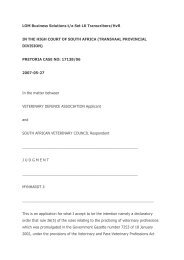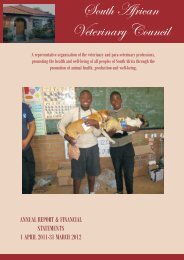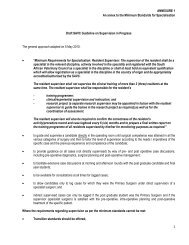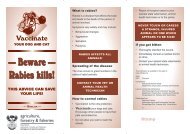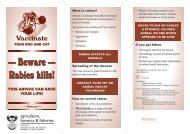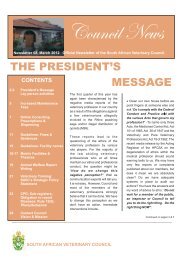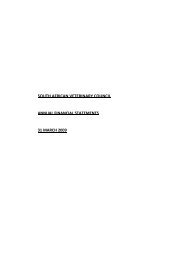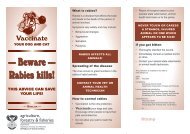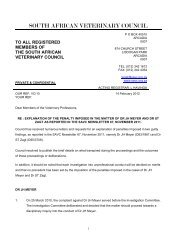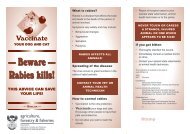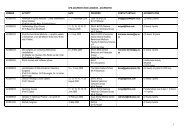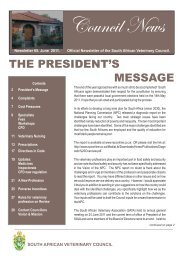Rabies Guide 2010.pdf - the South African Veterinary Council
Rabies Guide 2010.pdf - the South African Veterinary Council
Rabies Guide 2010.pdf - the South African Veterinary Council
Create successful ePaper yourself
Turn your PDF publications into a flip-book with our unique Google optimized e-Paper software.
Transmission and epidemiology<br />
An understanding of <strong>the</strong> importance of <strong>the</strong> virushost-environment<br />
relationship is crucial to<br />
understanding <strong>the</strong> complex epidemiology of animal<br />
rabies. 20 With recent developments in monoclonal<br />
antibody technology and gene sequencing, it is<br />
possible to demonstrate that distinct variants of rabies<br />
viruses (Lyssavirus type 1) have become adapted<br />
to specific hosts. The <strong>South</strong> <strong>African</strong> canid strain<br />
appears to be homogeneous whereas <strong>the</strong>re are at<br />
least four or five mongoose strains. Within <strong>the</strong><br />
mongoose strains, an association has been shown with<br />
different yellow mongoose populations occurring in<br />
geographically distinct areas. 18,32,163 The underlying<br />
causes of rabies-virus-host preference and <strong>the</strong> factors<br />
that determine <strong>the</strong> propensity of a rabies virus<br />
strain to spread, or become compartmentalised, have<br />
not been elucidated. <strong>Rabies</strong> does not appear to<br />
have an extended asymptomatic carrier phase and a<br />
symptomless carrier animal, which sheds rabies virus<br />
but does not succumb to <strong>the</strong> disease, has not been<br />
demonstrated in <strong>South</strong> Africa. Animals infected with<br />
rabies virus succumb to <strong>the</strong> disease.<br />
More than 300 animal rabies (Lyssavirus type 1)<br />
isolates from KwaZulu-Natal have been typed using<br />
monoclonal antibodies and <strong>the</strong>se have all proved to<br />
be canid strain. 21 This finding clearly implicates <strong>the</strong><br />
domestic dog as <strong>the</strong> reservoir species in that province<br />
and is justification for <strong>the</strong> veterinary authorities’<br />
policy of intensive dog vaccination. A good knowledge<br />
of local dog ecology (dog numbers, turnover rates,<br />
reasons for ownership, o<strong>the</strong>r diseases, housing) is<br />
crucial when planning control measures. Feral dogs<br />
do not appear to be an important factor in KwaZulu-<br />
Natal and <strong>the</strong>refore owners’ management of <strong>the</strong>ir<br />
dogs should not be overlooked.<br />
Dog rabies is almost exclusively<br />
endemic in developing countries<br />
where control measures are difficult<br />
to apply and education of <strong>the</strong> public is<br />
complicated by competing priorities.<br />
Dog rabies has often erroneously<br />
been referred to as “urban” rabies<br />
but <strong>the</strong> disease is clearly a rural<br />
problem in many parts of <strong>the</strong> Eastern<br />
Cape, Mpumalanga and KwaZulu-<br />
Natal. The term “urban” may have<br />
originated with <strong>the</strong> belief that urban<br />
domestic dogs maintained a rabies<br />
Humans, cattle<br />
and o<strong>the</strong>r<br />
domestic animals<br />
are <strong>the</strong> main<br />
victims of canine<br />
rabies in dog<br />
rabiesendemic<br />
regions<br />
cycle that originated from sylvatic mongoose rabies<br />
spreading to dogs in <strong>South</strong> Africa. 20<br />
The identification of different rabies variants by<br />
means of monoclonal antibody typing and gene<br />
sequencing has put this postulate to rest.<br />
Canine rabies is currently endemic in <strong>the</strong> nor<strong>the</strong>astern<br />
regions of <strong>the</strong> Eastern Cape, <strong>the</strong> entire<br />
KwaZulu-Natal, and <strong>the</strong> eastern and south-eastern<br />
areas of Mpumalanga adjoining Swaziland. 21,30 Within<br />
<strong>the</strong>se regions, prevalence appears to be highest in areas<br />
with <strong>the</strong> highest human densities. Human migration<br />
has increased considerably during <strong>the</strong> past decade and<br />
it may only be a matter of time before canine rabies<br />
makes its presence felt in o<strong>the</strong>r densely populated<br />
areas of <strong>the</strong> country.<br />
During <strong>the</strong> past 30 years, <strong>the</strong> canid strain of rabies<br />
virus has accounted for most black-backed jackal<br />
rabies cases in <strong>the</strong> Limpopo Province and bat-eared<br />
fox rabies cases in <strong>the</strong> Nor<strong>the</strong>rn Cape, Free State<br />
and Eastern Cape. A rabid black-backed jackal,<br />
some 20 km from Soweto, yielded <strong>the</strong> canid strain<br />
in 1995. Why large-scale spreading to <strong>the</strong> local dog<br />
populations did not occur, remains a mystery.<br />
Humans, cattle and o<strong>the</strong>r domestic animals are<br />
<strong>the</strong> main victims of canid rabies in dog rabiesendemic<br />
regions. 21,30 In <strong>the</strong> Limpopo and North<br />
West Provinces, cattle are most frequently affected by<br />
outbreaks in black-backed jackal. Epidemics appear<br />
to occur in cycles of eight to 10 years, and two<br />
specific epidemics from 1974 to 1980 and 1988 to<br />
1996 had significant economic implications. During<br />
<strong>the</strong> former more than 1 000 cattle succumbed to<br />
clinical rabies on 93 farms (H. van de Pypekamp,<br />
personal communication). <strong>Rabies</strong><br />
in jackal was controlled by poison<br />
baits until <strong>the</strong> 1980s. This method<br />
proved unsuccessful and often led<br />
to <strong>the</strong> death of nontarget species.<br />
It has since been replaced by mass<br />
vaccination of livestock in endemic<br />
areas with far better results. Unlike<br />
dog rabies, sylvatic rabies may be<br />
influenced to a far greater extent<br />
by seasonal availability of water<br />
and food. Competition between<br />
species during <strong>the</strong> mating season and<br />
dispersal of progeny seeking new<br />
territories, appear to be important<br />
14



